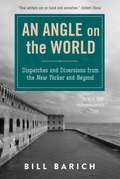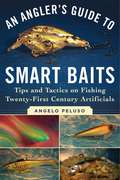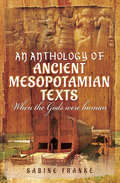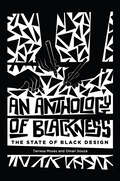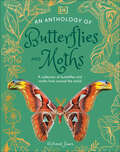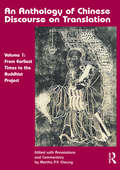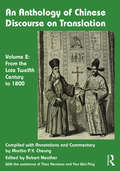- Table View
- List View
An Angel's Apprentice: An Angel's Apprentice (Daniel Winkcler Ser.)
by D. D. AnginniAn Angel's Apprentice is a fictional work of youth literature set in the world of fantasy and the story tells of an epic battle among the most powerful angels of Eden (the Seals) and how Daniel Winkcler will wake these creatures in order to save Humanity. You hold in your hands a powerful artefact capable of transporting you into a fantastical adventure with the oldest and most powerful beings that have ever lived on Earth: the Celestial Seals. Enter into Daniel Winkcler's universe, a fifteen year old kid who turns out to be the key figure in an ancient battle. Guided by his master, Jihlava, and counting on his friends by his side, Daniel will need to learn how to control his new powers, take on daunting enemies and wake up the oldest and most invincible Seals leveling out the balance of powers between the Rebels and the Resistence. Only then will he prevent a new Armageddon from destroying Humanity. The gateway you are holding will take you through a succession of battles, chases, mysticism, legends, tournaments, treasure hunts and romance that are enough to take away the breath of any hero. Get ready for this unforgettable journey and open up the book. Have fun!
An Angel's Story: The First Christmas From Heaven's View
by Max LucadoIn this book, Max Lucado uses his imagination and scripture to tell the Christmas story from heaven's view with all of the spiritual warfare that might have occurred.
An Angle on the World: Dispatches and Diversions from the New Yorker and Beyond
by Bill BarichSpanning over thirty years of writing, An Angle on the World is a wonderful collection of articles that cross the globe and introduce readers to many characters, introduced as only Bill Barich can. As said by Time magazine, Barich's touch is always "artful and compassionate."Broken up into two sections, Barich shares stories of the people, from those that have shaken him to the core, to others from a much lighter place.As he notes in his introduction, "I've spent much of my writing life indulging curiosity, throwing myself into situations and subcultures to gain an education and acquire my own angle on the world. The dispatches collected here arose from that desire."From the troubles in Northern Ireland and the homeless in San Francisco to the US-Mexico borders, Barich went to the people to find the "real story. These are his dispatches. "They all explore stories the press had ignored or covered in a desultory way, at least in my view." While doing his research for these pieces, Barich would speak with grocers, butchers, and even barbers to get his story, knowing that they would give him the truth, as opposed to those that would try to skew reality for someone writing for a magazine.Barich also shows the other side of things, as he speaks about diversions of a "lighter fare." From meetings with Jerry Garcia and trips to Barbados and Culebra, readers will enjoy the work that has kept Barich busy for so many decades, and helped him become one of the most enjoyable writers of our time.An Angle on the World is a terrific compilation from a brilliant writer that offers a raw sense of reality from the people who live it. No filter, no fluff, just the truth as Barich told it. They're real and genuine stories, and shown from a caring point of view that make this collection a definite can't-miss.
An Angler's Guide to Smart Baits: Tips and Tactics on Fishing Twenty-First Century Artificials
by Angelo Peluso Mark SosinFishing is one of the oldest continually practiced pastimes in history. But like almost everything else in our modern era, it too has been greatly influenced by ever-changing technology and scientific advances. With busy lives, it's often impossible for anglers to keep up with constantly evolving equipment. In An Angler's Guide to Smart Baits: Tips and Tactics on Fishing Twenty-First Century Artificials, veteran fisherman Angelo Peluso helps to navigate these often unsure waters of modern baits and how to fish them. Peluso takes readers through all the essential elements. Among the topics he explains, in depth, are: the appeal and purpose of materials used in modern lure construction, including hi-tech, durable plastics, acrylics and other polymers, and new-age finishes that give impressions of life; the modern science of both hard and soft baits; the sensory appeal of modern baits; and how to maximize a bait?s appeal to yield the most strikes and increase an angler's catch ratios. Including advice and input from expert lure designers, scientists, and manufacturers, An Angler's Guide to Smart Baits is an essential read for every modern fisherman.
An Anglo-Saxon Reader in Prose and Verse: With Grammatical Introduction, Notes, And Glossary (classic Reprint)
by SweetFirst published in 2005. Routledge is an imprint of Taylor & Francis, an informa company.
An Anglo-Welsh Teaching Dynasty: The Adams Family from the 1840s to the 1930s
by William E. MarsdenOver a period of about 90 years, six members of the Adams family, originally from Pembrokeshire, were teachers in Wales and England. This account of their experiences and methods illustrates educational continuity and change during a century of development.
An Animal a Day: 365 Amazing Animals to Take You Through the Year
by Miranda SmithDiscover a fascinating new animal for every day of the year! The perfect gift for animal lovers aged 6 and up.New day, new animal!In this gorgeous calendarized collection, you'll travel through the incredible ecosystems and habitats of our wild planet and meet 365 of the amazing animals that call it home.Dive into the oceans to find whales and giant squid, soar though skies with eagles and snowy owls, race across the African savanna with lions and wildebeest—and so much more. Each day&’s entry is filled with fascinating facts and breathtaking illustrations that bring animals to life. You'll encounter familiar favorites, plus find out new sides to critters you thought you already knew and learn about completely new animals.Packed with engaging info, this book also features information about conservation and how we can protect endangered animals and their environments.It's the ultimate gift for any animal lover, from age 6 to 106!
An Animal for Alan
by Edward R. RicciutiQuoting from the book: Alan wants a pet animal, an animal that he can keep at home. When Alan and his father go for a walk in the country, Alan sees several wild animals that he wants to take home. But Alan learns on this walk, and later at the zoo, which wild animals must live in their natural habitats and which animals can be kept as pets. Woven into this lively, easy-to-read story are many interesting facts about animals, such as the way in which killdeer protect their young, why a fawn is usually safe during the first few days of its life, and why monkeys need the company of other monkeys. The sprightly drawings bring freshness and humor to Alan's experiences in his search for a pet.
An Annotated Bibliography for Taiwan Film Studies
by James Jim Cheng Wicks Noguchi SachieCompiled by two skilled librarians and a Taiwanese film and culture specialist, this volume is the first multilingual and most comprehensive bibliography of Taiwanese film scholarship, designed to satisfy the broad interests of the modern researcher. The second book in a remarkable three-volume research project, An Annotated Bibliography for Taiwan Film Studies catalogues the published and unpublished monographs, theses, manuscripts, and conference proceedings of Taiwanese film scholars from the 1950s to 2013. Paired with An Annotated Bibliography for Chinese Film Studies (2004), which accounts for texts dating back to the 1920s, this series brings together like no other reference the disparate voices of Chinese film scholarship, charting its unique intellectual arc. <P><P>Organized intuitively, the volume begins with reference materials (bibliographies, cinematographies, directories, indexes, dictionaries, and handbooks) and then moves through film history (the colonial period, Taiwan dialect film, new Taiwan cinema, the 2/28 incident); film genres (animated, anticommunist, documentary, ethnographic, martial arts, teen); film reviews; film theory and technique; interdisciplinary studies (Taiwan and mainland China, Taiwan and Japan, film and aboriginal peoples, film and literature, film and nationality); biographical materials; film stories, screenplays, and scripts; film technology; and miscellaneous aspects of Taiwanese film scholarship (artifacts, acts of censorship, copyright law, distribution channels, film festivals, and industry practice). Works written in multiple languages include transliteration/romanized and original script entries, which follow universal AACR-2 and American cataloguing standards, and professional notations by the editors to aid in the use of sources.
An Annotated Bibliography of Chinese Painting Catalogues and Related Texts (Michigan Monographs In Chinese Studies #16)
by Hin-Cheung LovellThe student of Chinese painting must from time to time consult John C. Ferguson’s Li-tai chu-lu hua mu, an index to Chinese paintings recorded in Chinese catalogues. The catalogues in which the paintings are compiled are of equal interest: their compilers, the date of their compilation, their scope, their derivation, their merits and shortcomings, and so on. An Annotated Bibliography of Chinese Painting Catalogues and Related Texts provides a way for English-language students with limited knowledge of Chinese to find basic information on the catalogues in an easily available form.
An Anomalous Jew: Paul among Jews, Greeks, and Romans
by Michael F. BirdLively, well-informed portrait of the complex figure who was the apostle Paul Though Paul is often lauded as the first great Christian theologian and a champion for Gentile inclusion in the church, in his own time he was universally regarded as a strange and controversial person. In this book Pauline scholar Michael Bird explains why. An Anomalous Jew presents the figure of Paul in all his complexity with his blend of common and controversial Jewish beliefs and a faith in Christ that brought him into conflict with the socio-religious scene around him. Bird elucidates how the apostle Paul was variously perceived — as a religious deviant by Jews, as a divisive figure by Jewish Christians, as a purveyor of dubious philosophy by Greeks, and as a dangerous troublemaker by the Romans. Readers of this book will better understand the truly anomalous shape of Paul’s thinking and worldview.
An Anomalous Jew: Paul among Jews, Greeks, and Romans
by Michael F. BirdLively, well-informed portrait of the complex figure who was the apostle Paul Though Paul is often lauded as the first great Christian theologian and a champion for Gentile inclusion in the church, in his own time he was universally regarded as a strange and controversial person. In this book Pauline scholar Michael Bird explains why. An Anomalous Jew presents the figure of Paul in all his complexity with his blend of common and controversial Jewish beliefs and a faith in Christ that brought him into conflict with the socio-religious scene around him. Bird elucidates how the apostle Paul was variously perceived — as a religious deviant by Jews, as a divisive figure by Jewish Christians, as a purveyor of dubious philosophy by Greeks, and as a dangerous troublemaker by the Romans. Readers of this book will better understand the truly anomalous shape of Paul&’s thinking and worldview.
An Answer to the Question: 'What is Enlightenment?' (Penguin Great Ideas)
by Immanuel KantImmanuel Kant was one of the most influential philosophers in the whole of Europe, who changed Western thought with his examinations of reason and the nature of reality. In these writings he investigates human progress, civilization, morality and why, to be truly enlightened, we must all have the freedom and courage to use our own intellect. Throughout history, some books have changed the world. They have transformed the way we see ourselves - and each other. They have inspired debate, dissent, war and revolution. They have enlightened, outraged, provoked and comforted. They have enriched lives - and destroyed them. Now Penguin brings you the works of the great thinkers, pioneers, radicals and visionaries whose ideas shook civilization and helped make us who we are.
An Anthology of American Folktales and Legends
by Frank de CaroFor folklorists, students, as well as general readers, this is the most comprehensive survey of American folktales and legends currently available. It offers an amazing variety of American legend and lore - everything from Appalachian Jack tales, African American folklore, riddles, trickster tales, tall tales, tales of the supernatural, legends of crime and criminals, tales of women, and even urban legends.The anthology is divided into three main sections - Native American and Hawaiian Narratives, Folktales, and Legends - and within each section the individual stories explore the myriad narrative traditions and genres from various geographic regions of the United States. Each section and tale genre is introduced and placed in its narrative context by noted folklorist Frank de Caro. Tale type and motif indexes complete the work.
An Anthology of Ancient Mesopotamian Texts: When the Gods were Human
by Sabine FrankeLearn about the ancient civilizations of Iraq and Syria, through the stories they told. This book gathers the best stories of ancient Near Eastern literature surrounding the Mesopotamian gods, men, and kings. It takes the reader on a journey back to the birth of literature in Mesopotamia—which at the same time seems so distant yet so familiar. Fairy tales, myths, and epics of this region are still able to entertain readers today—and allow us to delve into the fascinating life of this ancient civilization. This book includes fables such as that of the tooth worm, which causes tooth pain, as well as the great myth of Innanas, which describes the goddess Ishtar&’s transition to the underworld. There are also stories of daily life, such as that of a student, and the Sumerian incantations against a crying baby.
An Anthology of Aquatic Life (DK Children's Anthologies)
by Sam HumeDive into the wondrous world of water and discover the stories of more than 100 incredible aquatic lifeforms.The underwater world is so much bigger than young minds can fathom and there is always more to learn. An Anthology of Aquatic Life is a stunning ocean encyclopedia for young readers to explore, with reference pages packed with fascinating information, little learners will be captivated as they discover the facts, stories and myths behind their favourite sea-life animals. From the deepest, widest ocean to the tiniest puddle, this beautiful compendium takes young readers on an enthralling journey through the aquatic world, meeting amazing animals, ingenious plants, and much more along the way. Stunning photography and gorgeous illustrations complement storybook descriptions about each lifeform, and children can uncover hundreds of fascinating facts as they read. Did you know that elephant seals can hold their breath underwater for more than an hour, or that the brown basilisk reptile can run across water? Discover the science of how plants have learnt to live, feed, and breathe in water, and take a look at the unique challenges of distinct ecosystems on feature spreads about rivers, lakes, wetlands, and more. Celebrate your child&’s curiosity as they:- Explore detailed photographs and striking illustrations of nature in action- Reveal fun facts and myths about how a range of animals and plants adapt to their environments- Uncover more than 100 aquatic lifeforms, each with stunning images and captivating information.This ocean encyclopedia for children is the perfect blend of storybook style text with out of this world illustrations which makes it a fantastic sea life book for children who are obsessed with the underwater world. Encourage young readers to go on a journey to explore a world of information, making this the ideal first reference book for kids aged 7-9 to enjoy for hours on end, whether reading with the family or reading alone, this fun fact book also doubles up as the perfect gift for curious kids who love to learn. Explore the diversity of the animal kingdom whilst uncovering: -Stunning Jacket Detail: gold foil, holographic foil & metallic gold edges-Stunning photography & illustrations inside-A beautiful book for the whole family to treasure -A quality gift to be passed down through the generationsMore in the SeriesAnthology of Aquatic Animals is part of the beautiful and informative Anthology series. Complete the series and nurture your child's curiosity as they explore the natural world with The Wonders of Nature or let them walk with the dinosaurs who ruled the earth before them in Dinosaurs and other Prehistoric Life.
An Anthology of Blackness: The State of Black Design
by Terresa Moses Omari SouzaAn adventurous collection that examines how the design field has consistently failed to attract and support Black professionals—and how to create an anti-racist, pro-Black design industry instead.An Anthology of Blackness examines the intersection of Black identity and practice, probing why the design field has failed to attract Black professionals, how Eurocentric hegemony impacts Black professionals, and how Black designers can create an anti-racist design industry. Contributing authors and creators demonstrate how to develop a pro-Black design practice of inclusivity, including Black representation in designed media, anti-racist pedagogy, and radical self-care. Through autoethnography, lived experience, scholarship, and applied research, these contributors share proven methods for creating an anti-racist and inclusive design practice.The contributions in An Anthology of Blackness include essays, opinion pieces, case studies, and visual narratives. Many contributors write from an intersectional perspective on race, gender, sexuality, ethnicity, and ability. Each section of the book expands on community-driven concerns about the state of the design industry, design pedagogy, and design activism. Ultimately, this articulated intersection of Black identity and Black design practice reveals the power of resistance, community, and solidarity—and the hope for a more equitable future. With a foreword written by design luminary Elizabeth (Dori) Tunstall, An Anthology of Blackness is a pioneering contribution to the literature of social justice.Contributors Kprecia Ambers, Jazmine Beatty, Anne H. Berry, John Brown VI, Nichole Burroughs, Antionette D. Carroll, Jillian M. Harris, Asher Kolieboi, Terrence Moline, Tracey L. Moore, Lesley-Ann Noel, Pierce Otlhogile-Gordon, Jules Porter, Stacey Robinson, Melanie Walby, Jacinda N. Walker, Kelly Walters, Jennifer White-Johnson, Maya Aduba Williams, S. Alfonso Williams
An Anthology of Butterflies and Moths: A Collection of Butterflies and Moths from Around the World (DK Little Anthologies)
by Richard JonesA beautiful field guide featuring notes, photos, and illustrations of more than 100 species of butterflies and moths.A compact version of DK’s bestselling anthology series, An Anthology of Butterflies and Moths is perfect for young bug enthusiasts aged 7-9 for taking on the go.Children can marvel at the many beautiful and delicate creatures covered, including the monarch butterfly, the blue morpho, the luna moth, and much more – all beautifully detailed through illustrations, photographs, and annotations explaining each one.This impressive butterfly and moth anthology for kids offers:A handheld, compact version of DK's hugely successful Anthology series.A wide selection of species featured throughout, each accompanied by a beautiful photograph and an illustration.A quality gift book, with metallic foil and striking photographs on every page.An Anthology of Butterflies and Moths pairs photography with storybook descriptions that will captivate young readers as they learn about these delicate creatures from all around the world. Featuring photographs of striking creatures and illustrations by the artist behind DK’s bestselling Anthology series, as well as plenty of intriguing information, this book will be one to treasure for young nature enthusiasts.More in the seriesAn Anthology of Butterflies and Moths is part of the beautiful, new and compact Anthology spin-off series. Complete the series and nurture your child's curiosity as they explore different mushroom species with An Anthology of Fungi and An Anthology of Rocks and Minerals.
An Anthology of Chinese Discourse on Translation (Version 1): From Earliest Times to the Buddhist Project
by Martha Cheung Pui Yiu Lin WusunTranslation has a long history in China. Down the centuries translators, interpreters, Buddhist monks, Jesuit priests, Protestant missionaries, writers, historians, linguists, and even ministers and emperors have all written about translation, and from an amazing array of perspectives. Such an exciting diversity of views, reflections and theoretical thinking about the art and business of translating is now brought together in a two-volume anthology. The first volume covers a time-frame from roughly the 5th century BCE to the twelfth century CE. It deals with translation in the civil and government context, and with the monumental project of Buddhist sutra translation. The second volume spans the 13th century CE to the Revolution of 1911, which brought an end to feudal China. It deals with the transmission of Western learning to China - a translation venture that changed the epistemological horizon and even the mindset of Chinese people. Comprising over 250 passages, most of which are translated into English for the first time here, the anthology is the first major source book to appear in English. It carries valuable primary material, allowing access into the minds of translators working in a time and space markedly different from ours, and in ways foreign or even inconceivable to us. The topics these writers discussed are familiar. But rather than a comfortable trip on well-trodden ground, the anthology invites us on an exciting journey of the imagination.
An Anthology of Chinese Discourse on Translation (Volume 2): From the Late Twelfth Century to 1800
by Martha CheungTranslation has a long history in China. Down the centuries translators, interpreters, Buddhist monks, Jesuit priests, Protestant missionaries, writers, historians, linguists, and even ministers and emperors have all written about translation, and from an amazing array of perspectives. This second volume of the seminal two-volume anthology spans the 13th century CE to the very beginning of the nineteenth century with an entry dated circa 1800. It deals mainly with the transmission of Western learning to China – a translation venture that changed the epistemological horizon and even the mindset of Chinese people. Also included are texts that address translation between Chinese and the languages of China's Central Asian neighbours, such as Manchu, which was to become of crucial importance in the Qing Dynasty. Comprising 28 passages, most of which are translated into English for the first time here, the anthology is the first major source book of its kind to appear in English. It features valuable primary material, and is essential reading for postgraduate students and researchers working in the areas of Translation, Translation Studies and Asian Studies.
An Anthology of Exquisite Birds (DK Children's Anthologies)
by Ben HoareSoar through the sky with best-selling author Ben Hoare and discover some of the most exquisite birds on our planet.From the miniature bee hummingbird that flaps its wings 200 times a second, to the oilbird that navigates pitch-black caves using echolocation, this stunning collection showcases more than 90 of the world's most extraordinary birds. Detailed photography is paired with storybook descriptions that will captivate young readers, whether it's finding out about condors and cuckoos or swans and starlings. Features on eggs, feathers, nests, and other key topics explore the enormous variety of avian adaptations. There is also a visual index packed with reference information, including the size and range of each species.With foil on the cover, gilded edges, and a ribbon for keeping your place, An Anthology of Exquisite Birds makes a beautiful gift for any child who is fascinated by birds. It's ideal for young readers to explore by themselves or perfect for bedtime stories.
An Anthology of Fungi: A Collection of 100 Mushrooms, Toadstools and Other Fungi (DK Little Anthologies)
by Lynne Boddy Ali AshbyFind out how to identify, where to spot, and what to know about common woodland mushrooms and rare fungal finds with this beautiful field guide.Transportable in size and crammed with profiles of different mushrooms, An Anthology of Fungi covers toadstool species including fly agaric, porcelain fungus, velvet shank, wood blewit, and crimson waxcap, as well as lichens, brackets, and more.Featuring photographs of striking specimens and illustrations by the artist behind DK’s best-selling Anthology series, as well as plenty of intriguing information, this book will be one to treasure for young nature enthusiasts.
An Anthology of Global Risk
by SJ Beard;Tom HobsonThis anthology brings together a diversity of key texts in the emerging field of Existential Risk Studies. It serves to complement the previous volume The Era of Global Risk: An Introduction to Existential Risk Studies by providing open access to original research and insights in this rapidly evolving field. At its heart, this book highlights the ongoing development of new academic paradigms and theories of change that have emerged from a community of researchers in and around the Centre for the Study of Existential Risk. The chapters in this book challenge received notions of human extinction and civilization collapse and seek to chart new paths towards existential security and hope. The volume curates a series of research articles, including previously published and unpublished work, exploring the nature and ethics of catastrophic global risk, the tools and methodologies being developed to study it, the diverse drivers that are currently pushing it to unprecedented levels of danger, and the pathways and opportunities for reducing this. In each case, they go beyond simplistic and reductionist accounts of risk to understand how a diverse range of factors interact to shape both catastrophic threats and our vulnerability and exposure to them and reflect on different stakeholder communities, policy mechanisms, and theories of change that can help to mitigate and manage this risk. Bringing together experts from across diverse disciplines, the anthology provides an accessible survey of the current state of the art in this emerging field. The interdisciplinary and trans-disciplinary nature of the cutting-edge research presented here makes this volume a key resource for researchers and academics. However, the editors have also prepared introductions and research highlights that will make it accessible to an interested general audience as well. Whatever their level of experience, the volume aims to challenge readers to take on board the extent of the multiple dangers currently faced by humanity, and to think critically and proactively about reducing global risk.
An Anthology of Informal Latin, 200 BC – AD 900
by Adams J. n.This book contains over fifty passages of Latin from 200 BC to AD 900, each with translation and linguistic commentary. It is not intended as an elementary reader (though suitable for university courses), but as an illustrative history of Latin covering more than a millennium, with almost every century represented. Conventional histories cite constructions out of context, whereas this work gives a sense of the period, genre, stylistic aims and idiosyncrasies of specific passages. 'Informal' texts, particularly if they portray talk, reflect linguistic variety and change better than texts adhering to classicising norms. Some of the texts are recent discoveries or little known. Writing tablets are well represented, as are literary and technical texts down to the early medieval period, when striking changes appear. The commentaries identify innovations, discontinuities and phenomena of long duration. Readers will learn much about the diversity and development of Latin.
An Anthology of Intriguing Animals (DK Children's Anthologies)
by DKReveal the stories behind your favourite creatures with this awe-inspiring animal book for curious kids aged 6-8.The animal kingdom is so much bigger than young minds can fathom and there is always more to learn. An Anthology of Intriguing Animals is a stunning animal encyclopedia for young readers to explore, with reference pages packed with fascinating information, little learners will be captivated as they discover the facts, stories and myths behind their favourite animals. Whether it&’s where the slow-motion sloth lives, how the plodding pangolin protects itself from predators, or which animal the Ancient Egyptians thought rolled the Sun across the sky, children can learn all sorts of fun animal facts from the storybook descriptions.This beautiful modern bestiary lets you find the animals that interest you and uncover new favourites along the way. From tigers and chameleons to wolves and owls there&’s an animal for everyone in this compendium of creatures. Each type of animal is shown both photographically and illustrated, and children will love poring over the detailed close-up images. The engaging storybook-style descriptions and simple text shed a light on the wonders of wildlife and array of animals, perfect for children aged 6-8 to love and explore for hours on end. Celebrate your child&’s curiosity as they:- Explore detailed photographs and striking illustrations of animals around the world - Reveal fun facts and myths about a wide range of animals - Uncover more than 100 animals, each with stunning images and captivating information.This animal encyclopedia for children is the perfect blend of storybook style text with out of this world illustrations which makes it a fantastic animal book for children who are obsessed with the animal kingdom. Encourage young readers to go on a journey to explore a world of information, making this the ideal first reference book for kids aged 6-8 to enjoy for hours on end, whether reading with the family or reading alone, this fun fact book also doubles up as the perfect gift for curious kids who love to learn. Explore the diversity of the animal kingdom whilst uncovering: -Stunning Jacket Detail: gold foil, holographic foil & metallic gold edges-Stunning photography & illustrations inside-A beautiful book for the whole family to treasure -A quality gift to be passed down through the generationsMore in the SeriesAn Anthology of Intriguing Animals is part of the beautiful and informative Anthology series. Complete the series and nurture your child's curiosity as they explore the natural world with The Wonders of Nature or let them walk with the dinosaurs who ruled the earth before them in Dinosaurs and other Prehistoric Life.


